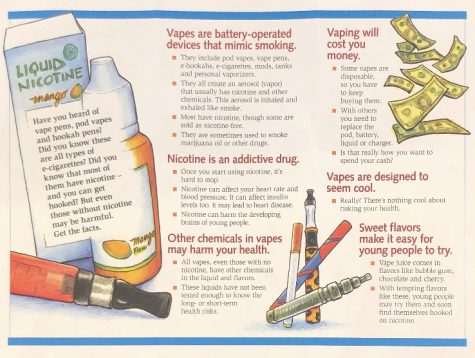Vaping- What You Should Know

Vaping has become an issue for schools everywhere in America. The first E-Cigarette was introduced in 2006 by a Chinese pharmacist named Hon Lik. Hin Lik worked for the company Golden Dragon Holdings. Vaping or Juuling was not always popular. In 2011 only approximately 7 million people were vaping, but over just a few years, that number jumped to 25 million people in 2014. Studies from the year 2020 show that more than 20% of high school students and about 5% of middle school students were vaping. When asked about vaping on our campus, Campus Supervisor, Ariel Villanueva shared, “It’s become more of an issue now, and parents should be more aware of what their kids are doing, especially bringing it (vape pens) to school.”
Vapes often contain toxic metals such as arsenic, chromium, nickel, and lead that may cause health issues. Because vaping products are relatively new, their long-term health effects are still largely unknown. However, the information that is available suggests several health risks, including lung injuries, burns, and nicotine and cannabis use disorders. According to John Hopkins University, there has been an outbreak of lung injuries and deaths associated with vaping. In February 2020, the Centers for Disease Control and Prevention (CDC) confirmed 2,807 cases of e-cigarette or vaping use-associated lung injury (EVALI) and 68 deaths attributed to that condition. Their research on vape ingredients revealed thousands of chemical ingredients in vape products, the majority of which are not even identifiable. Those the researchers could identify were several potentially harmful substances, including caffeine, three chemicals never previously found in e-cigarettes, a pesticide, and two flavorings with possible toxic effects and respiratory irritation.
While the dangers of secondhand cigarette smoke are well-known, the science is still unfolding on how secondhand vapor, or aerosol, affects the body. According to research being connected at the University of Southern California, people may be underestimating the health risk of secondhand vapor. USC’s research found that exposure to secondhand aerosols from e-cigarettes is associated with an increased risk of bronchitis symptoms and shortness of breath among young adults, especially among those who don’t smoke or vape. From 2015 and 2017, 1 in 4 students were exposed to secondhand e-cigarette aerosols, and that figure grew to 1 in 3 students in 2018, according to a 2019 study in JAMA Network Open. Secondhand vapor is also an issue here on our campus. Campus Supervisor, Evan Thomas stated, “The restrooms are where the majority of vaping activity is happening on our campus, and they’re full of it (vapor). There are some students that don’t do it or like it (vape) and want to use the restrooms. It’s affecting those kids and that’s not fair.”
Sadly, most students don’t think about vaping (or Juuling) as smoking. In the state of California, while it is not illegal for a juvenile to possess a vaping device, it is a crime for them to use it.
Facts About Vaping
- The human brain is sensitive to nicotine until about the age of 25 years old meaning it can cause brain damage
- It takes just a few seconds for nicotine to reach the brain and cause a chemical reaction in your brain and the rest of your body
- Nicotine harms brain circuits that control attention and learning which may lead to mood disorders and problems with impulse control
- The brain changes caused by nicotine increase the risk of addiction to nicotine as well as addiction to other drugs
- Nicotine harms blood vessels and can increase the risk of heart attack and stroke
- Vape pens and e-cigarettes are NOT approved by the U.S FDA which means there are no quality control standards that must be followed by manufacturing companies
*If you are vaping and would like to get help quitting, call 800-QUITNOW (784-8669), text “QUIT” to 47848, or visit smokefree.gov.












Vicky • Oct 23, 2022 at 9:18 am
Great article, I hope after researching for such an educational article you never vape ☠️. What a great idea to include a help line and web site.
Rogelio Campos • Nov 8, 2022 at 11:39 am
No, I will not vape. Thank you!